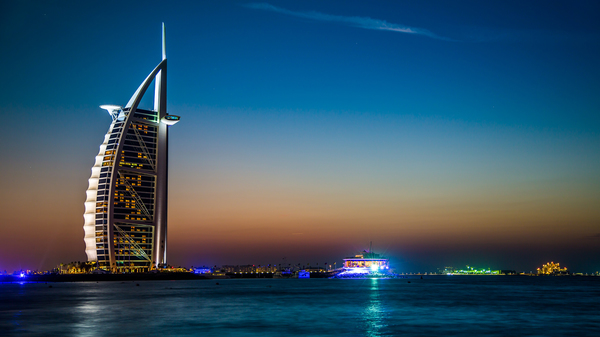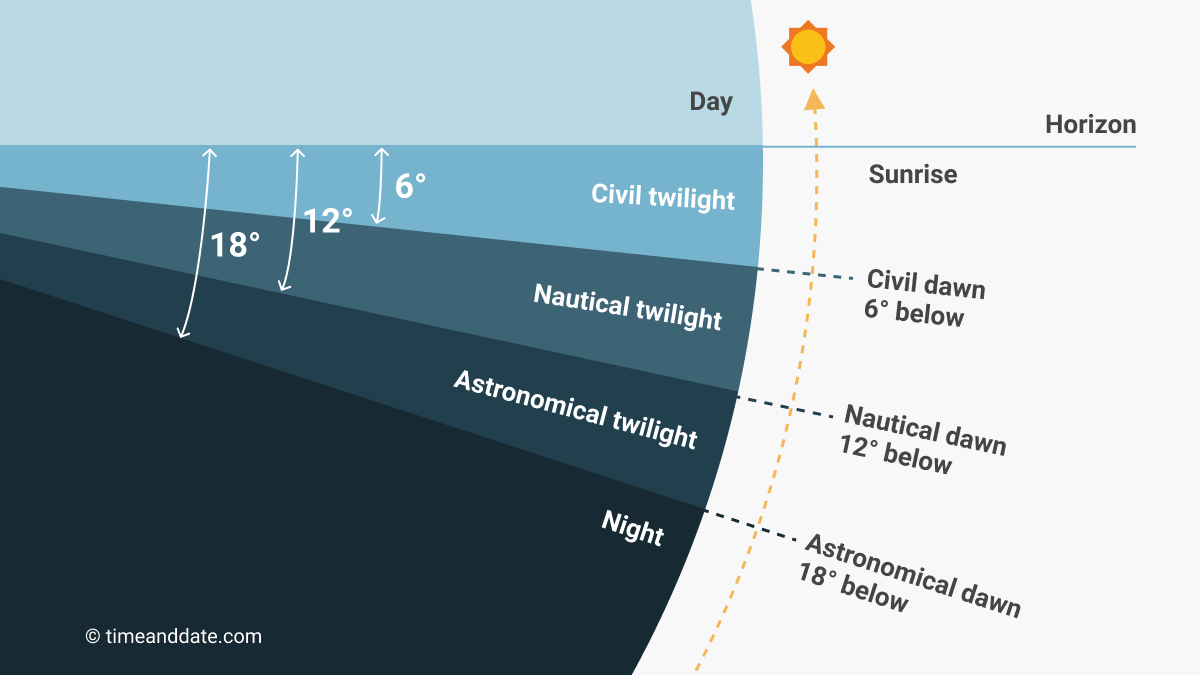How To Repair A Dusk To Dawn Light
Twilight is the time between day and night when there is light outside, but the Sun is below the horizon.

Dubai skyline in twilight.
©bigstockphoto.com/bloodua
Handful Sunlight
Twilight occurs when Globe'south upper atmosphere scatters and refracts sunlight which illuminates the lower atmosphere. A number of atmospheric phenomena and colors can be seen during twilight.
Types of Twilight
There are three types of twilight:
- Ceremonious twilight
- Nautical twilight
- Astronomical twilight
Astronomers ascertain the three stages of twilight on the ground of how far the Dominicus is beneath the horizon.
The morning twilight is ofttimes called dawn, while the evening twilight is also known equally dusk.
Astronomical terms & definitions


Different degrees of twilight.
@timeanddate.com
Ceremonious Twilight, Dawn, and Dusk
Civil twilight occurs when the Dominicus is less than vi degrees below the horizon. In the morn, ceremonious twilight begins when the Sun is vi degrees beneath the horizon and ends at sunrise. In the evening, it begins at sunset and ends when the Dominicus reaches 6 degrees beneath the horizon.
Civil dawn is the moment when the eye of the Sun is half dozen degrees beneath the horizon in the morning.
Ceremonious sunset is the moment when the center of the Sun is vi degrees beneath the horizon in the evening.
Brightest Form of Twilight
Civil twilight is the brightest form of twilight. In that location is enough natural sunlight during this period that bogus lite may non exist required to carry out outdoor activities. Only the brightest celestial objects can be observed by the naked eye during this time.
Several countries use this definition of civil twilight to make laws related to aviation, hunting, and the usage of headlights and street lamps.
Nautical Twilight, Dawn, and Sunset
Nautical twilight occurs when the center of the Sun is between vi degrees and 12 degrees below the horizon. This twilight period is less bright than ceremonious twilight and bogus light is generally required for outdoor activities.
Nautical dawn occurs when the Sun is 12 degrees below the horizon during the morning.
Nautical dusk occurs when the Sun is 12 degrees below the horizon in the evening.
The term, nautical twilight, dates back to the time when sailors used the stars to navigate the seas. During this time, most stars can be hands seen with naked eyes, and the horizon is ordinarily also visible in clear weather conditions.
In improver to being important to navigation on the seas, nautical twilight also has military implications. For example, the military forces of the The states use nautical twilight, every bit reflected by the terms brainstorm morning nautical twilight (BMNT) and end evening nautical twilight (EENT), to plan tactical operations.
Astronomical Twilight, Dawn, and Dusk
Astronomical twilight occurs when the Sun is between 12 degrees and 18 degrees below the horizon.
Astronomical dawn is the time when the eye of the Sun is at xviii degrees below the horizon.
Astronomical dusk is the instant when the center of the Sunday is at 18 degrees below the horizon.
During astronomical twilight, well-nigh angelic objects tin be observed in the sky. However, the atmosphere even so scatters and refracts a small corporeality of sunlight, and that may get in difficult for astronomers to view the faintest objects.
Before astronomical dawn and subsequently astronomical sunset, it is astronomical nighttime, when no indirect sunlight is visible and even faint celestial objects can be seen, weather permitting.
Shorter Twilight at the Equator
The length of twilight depends on the latitude. Equatorial and tropical regions tend to have shorter twilight than locations on higher latitudes.
During summer months at higher latitudes, at that place may be no distinction betwixt astronomical twilight afterward sunset and astronomical twilight before sunrise. This happens when the Sun never goes more than 18 degrees below the horizon during the night.
Similarly, higher latitudes may experience an extended period of nautical or civil twilight.
Twilight at the Poles

Nyksund lighthouse in Norway under the Midnight Sun.
©iStockphoto.com/elementals
Around the Due north Pole and the Due south Pole, each day-night cycle spans an entire year. In the summer, the poles experience Polar Day or Midnight Sun, when the Dominicus is upward in the sky for several months; in the winter, during the Polar Night, the Dominicus does not rise for several months.
The transitions between Polar Twenty-four hour period and Polar Night are marked by lengthy twilight periods. Once the Sun has disappeared behind the horizon in the fall, it slowly sinks lower each twenty-four hours, resulting in about two weeks of civil twilight, followed by nautical and astronomical twilight periods of roughly the same length. The opposite occurs in the bound, as the Polar Dark draws to a close and the Dominicus begins to illuminate the atmosphere several weeks before it actually rises.
Sunrise, sunset, and twilight at the South Pole
Source: https://www.timeanddate.com/astronomy/different-types-twilight.html
Posted by: hofferwasioneating.blogspot.com


0 Response to "How To Repair A Dusk To Dawn Light"
Post a Comment